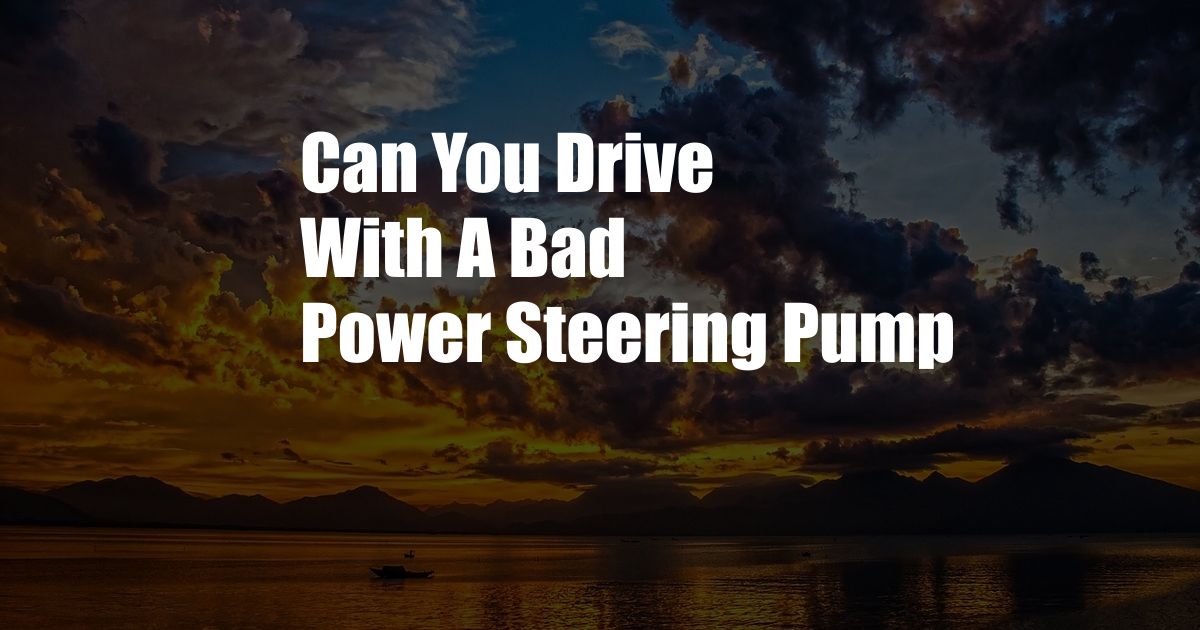
Can You Drive with a Bad Power Steering Pump?
Driving with a faulty power steering pump can be a perilous experience. I found myself in such a predicament on a busy highway, my steering wheel shaking violently, and my car lurching erratically. Fear gripped me as I struggled to maintain control. Fortunately, I managed to pull over safely and avoid a potentially catastrophic accident.
This harrowing experience made me realize the importance of understanding the signs and consequences of a failing power steering pump. In this comprehensive guide, we will delve into the topic, exploring its definition, symptoms, causes, and potential risks. Join us as we unravel the mysteries of a bad power steering pump and equip you with the knowledge to make informed decisions on the road.
What is a Power Steering Pump?
A power steering pump is a crucial component of modern vehicles, responsible for providing hydraulic assistance to the steering system. It utilizes a belt driven by the engine to generate hydraulic pressure, which is then transmitted to the steering rack or gearbox. This pressure significantly reduces the physical effort required to turn the steering wheel, enhancing maneuverability and driving comfort.
Symptoms of a Bad Power Steering Pump
Recognizing the signs of a faulty power steering pump is essential for ensuring your safety on the road. Below is a list of common symptoms:
- Stiff or heavy steering: A noticeable increase in the effort required to turn the steering wheel indicates a lack of hydraulic assistance.
- Whining or squealing noises: Worn or damaged components within the pump can create audible noises while turning the steering wheel.
- Leaking fluid: A visible pool of hydraulic fluid beneath your vehicle could signify a leak in the power steering system, including the pump.
- Vibration or shaking: A failing power steering pump can cause vibrations or shaking in the steering wheel, especially at low speeds.
- Reduced responsiveness: You may experience a delay or sluggishness in the steering system’s response to your inputs.
Causes of Power Steering Pump Failure
Several factors can contribute to the malfunctioning of a power steering pump:
- Worn or damaged components: Internal components, such as bearings, seals, or vanes, can wear out over time, leading to a loss of hydraulic pressure.
- Low fluid levels: Insufficient power steering fluid can cause the pump to overheat and fail.
- Contaminated fluid: Dirt, debris, or moisture in the hydraulic fluid can clog the system and damage the pump.
- Electrical issues: Faulty wiring or a malfunctioning sensor can disrupt the electrical signals to the pump, causing it to fail.
Risks of Driving with a Bad Power Steering Pump
Operating a vehicle with a faulty power steering pump poses significant risks, including:
- Reduced control: Loss of hydraulic assistance makes steering more difficult, impairing your ability to maneuver safely.
- Increased accident risk: The inability to control your vehicle effectively can lead to collisions.
- Vehicle damage: A failing power steering pump can cause damage to other components of the steering system.
Tips for Maintaining a Healthy Power Steering Pump
To prevent costly repairs and ensure the longevity of your power steering pump, follow these expert tips:
- Check fluid levels regularly: Monitor the power steering fluid reservoir and top up as needed.
- Change fluid periodically: Replace the power steering fluid according to the manufacturer’s recommended intervals.
- Inspect for leaks: Regularly inspect the power steering system for any signs of fluid leaks.
- Avoid overloading: Refrain from turning the steering wheel to its maximum lock position for extended periods.
FAQs on Power Steering Pumps
-
Can I drive with a bad power steering pump?
Driving with a faulty power steering pump is highly discouraged. The reduced control and increased risk of accidents make it dangerous. -
How long can I drive with a bad power steering pump?
It is difficult to determine an exact timeframe, as it depends on the severity of the problem. However, seeking professional assistance promptly is advisable. -
How much does it cost to replace a power steering pump?
The cost of replacing a power steering pump varies depending on the vehicle, parts availability, and labor rates. Expect to pay between $500 and $1,500.
Conclusion
A faulty power steering pump can jeopardize your safety on the road. By recognizing the warning signs and understanding the potential risks, you can make informed decisions and seek timely repairs. Remember, regular maintenance and expert advice are crucial for ensuring a healthy power steering system and a smooth driving experience.
We encourage you to share your experiences, questions, or concerns related to power steering pump issues in the comments section below. Your insights can benefit fellow readers and contribute to a more informed community of drivers.